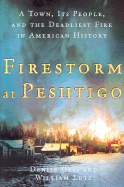

Of course, for years, the Peshtigo Fire was considered one of those once-in-a-century events with which we’ve become so familiar over the past decade or so. (Eames’ account can be found in the excellent Firestorm in Peshtigo by Denise Gess and William Lutz.) So I knew about the phenomenon, but not until this week did I know it had a name. A survivor named Phineas Eames wrote a letter in which he describes what he called “tornadoes” blocking a path he thought would lead to the safety of a ridge and knocking him to the ground.

It is believed that, at the height of the Peshtigo Fire, a tornado formed that swept through a carefully defined path from the forest to Peshtigo Harbor. The fire on October 8, 1871, the same day as the Great Chicago Fire and the result of the same climate conditions, burned 1.2 million acres in northern Wisconsin and killed somewhere between 1,500 and 2,000 people, some so badly burned that their bodies fell apart as they were being gathered up during the fire’s aftermath. I first became aware of this phenomenon because of one of my peculiar historical enthusiasms: the massive wildfire in Peshtigo, Wisconsin, the single most destructive fire in American history. "Later in the afternoon, that cloud will collapse and create a downdraft of heavy smoke, embers, things like that, and it can actually create additional fire behaviour," Lisa Cox, information officer for the western California fires told the Los Angeles Times. When the weather cools into the evening, the clouds can pose a danger as they fall to the ground.

But in some cases, they can also cause rain. Sometimes they can also create their own lightning, which can spark more fires. NASA calls pyrocumulonimbus "the fire-breathing dragon of clouds", because they funnel smoke like a chimney into the Earth's atmosphere, while hurling thunderbolts, wind and rain… When they form above fires, pyrocumulonimbus clouds can make the blaze spread even faster. With certain ground and atmospheric conditions, wildfires can rip through a large area with so much energy that they generate a pyrocumulonimbus, or "fire storm cloud”. And due to their ferocity, they are largely impossible to fight.įires that create their own weather systems. These are giant, fast-moving blazes so powerful they create their own weather systems akin to thunderstorms. Ready, class? Repeat after me.įrom the BBC : These pyrocumulonimbus clouds - dubbed "fire clouds" - can produce hurricanes and lightning, which can generate even more fires. They’ve added a new word to our vocabulary. Those clever Chinese climate hoaxers are at it again.


 0 kommentar(er)
0 kommentar(er)
